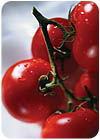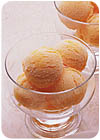
Imagine hearing the following product critique, "Product X has a rich, deep, satisfying and long-lasting taste." What manufacturer would not want those words spoken about its product? That would be the manufacturer that ignores umami's potential in dairy.

Although umami is most recognized as an attribute of savory Asian fish sauces or vine-ripened tomatoes, some say its usefulness as a fat replacement in dairy products is a concept worth exploring.
"Umami enhances the overall taste experience. Without it, food can taste shallow, insipid and fleeting," says Chef David Kasabian, who with his wife Anna co-authored The Fifth Taste: Cooking with Umami. "In an otherwise well-balanced dish, umami heightens the impact of salt, sweet and sour; and it masks bitter, improves palatability, contributes to mouthfeel and triggers salivation," says Kasabian.
Umami is created by the breakdown of proteins into amino acids, peptides and nucleotides during aging, cooking or fermenting processes. Scientists found the umami taste receptor in 2000, but it has been a recognized taste in Asia since the early 1900s.
Currently, umami is not as recognizable as sweet, salty, sour or bitter, but it can be distinctly perceived just as well as the other tastes. Since mother's milk is loaded with umami, it is not an acquired taste, but rather a taste that humans are engineered to desire. It is Kasabians theory that as Americans become more familiar with umami, they will better be able to identify it.

Some dairy products, particularly cheeses, already have umami taste.
"Cheeses that experience a long fermentation process usually have more umami," he says. Interestingly, cow's milk has very little umami, until it goes through the cheese making process. Goat milk and sheep milk tend to have more umami than cow milk. For example, fresh Chevre, (goat milk cheese) would have more umami than fresh Mozzarella. It might be beneficial for cheesemakers to research how they can best capitalize on the umami already present in their cheese.
In the dairy and dessert world, rather than relying on fish sauce itself to add umami taste, Kasabian presumes that manufacturers could use additives, like protein hydrosylates, MSG and some of the other amino acid ingredients that can be isolated from the flavors and aromas that are typically found in natural umami ingredients.
One possible incentive to adding umami ingredients is that they could provide mouthfeel in reduced-fat applications. At the annual 2006 Research Chefs Association Conference in Houston, Kasabian demonstrated how a broth takes on a thick almost fatty mouthfeel when umami is added.
"It would be interesting to see if one could replace some of the [attributes of] fat by using hydrosylates," he says. In theory, such an addition could possibly act as a flavor potentiator and improve the mouthfeel in a product like lowfat sour cream.
"The subject of umami has been restricted to savory foods only, but I think the potential for umami in dairy is tremendous," says Kasabian. "Some consider it a new tool, but it's always been there. Now that we know that it's there it opens up more possibilities to make many kinds of foods more satisfying and to also reduce fat and sugar. It's a new frontier."